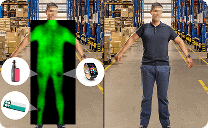In This article
Despite the digital wave sweeping through many business environments, the analog camera continues to hold its ground due to its simplicity, affordability, and compatibility with older infrastructure. They are a popular choice in retail, small businesses, and industrial facilities that have yet to embrace network-based solutions fully.
How Analog Cameras Work
The operation of an analog camera is a straightforward process:
- Image Capture: The camera captures images using a CCD (charge-coupled device) or CMOS sensor.
- The sensor converts light to electrical signals: The signals represent the brightness and color of each point in the image. The camera’s circuitry converts the raw signal into a format compatible with analog video standards (e.g., NTSC, PAL, or SECAM)
- Signal Transmission: The signal is transmitted in analog format via coaxial cable (typically RG59 or RG6) to a recording device.
- Video signal is recorded magnetically: The analog video signal is stored on magnetic tape (e.g., VHS, Hi8, Betacam) using spinning video heads in the camera’s tape mechanism. The Audio is recorded and stored simultaneously.
- Playback and Monitoring: Playing the tape sends the analog signal to a monitor or TV, where it’s decoded and displayed as moving images with sound.
The quality of footage from analog systems is determined by resolution standards like TVL (TV lines). However, newer analog formats such as HD-TVI and AHD have brought higher resolution capabilities (720p and above) to traditional coaxial setups.
Types of Analog Surveillance Technologies
Over time, several enhanced analog formats have emerged to extend the capabilities of traditional systems:
- Standard Analog (CVBS): Conventional analog with resolutions up to 960H; now largely outdated.
- HD-TVI (High Definition Transport Video Interface): Transmits HD video over coax without significant latency or loss.
- HD-CVI and AHD: Competing technologies that enable high-definition video over legacy cabling.
These enhanced formats allow businesses to upgrade their camera quality without replacing their entire cabling infrastructure, making them appealing for phased transitions.
Benefits and Limitations of Analog Cameras
Benefits:
- Lower cost for equipment and installation.
- Simple to set up with fewer network configuration requirements.
- Compatibility with existing coaxial infrastructure.
- Reliable performance with minimal network bandwidth impact.
Limitations:
- Lower resolution compared to digital or IP systems.
- Less scalability, as each camera requires a dedicated cable run to the recording device.
- Limited integration with other systems
- Limited features compared to digital cameras, unable to support smart features.
- Manual configuration and maintenance are often required for system updates.
While analog systems may still meet the needs of some environments, they lack the flexibility, intelligence, and scalability required for businesses seeking advanced surveillance capabilities.
Transitioning from Analog to IP
Many organizations begin with analog systems and later transition to IP-based solutions. Hybrid DVRs (often called XVRs) can support analog and IP cameras, helping businesses gradually migrate their infrastructure while preserving their original investment.
This approach allows for increased resolution, remote access, and AI-powered features, without entirely discarding existing hardware.
Evolve Beyond Analog with DTiQ
Whether operating on a legacy analog system or planning your transition to digital surveillance, DTiQ can offer expert guidance and flexible technology to support your journey at every stage. DTiQ solutions can integrate with analog and IP camera environments, helping ensure maximum visibility, data correlation, and loss prevention. With VIDEOiQ, you don’t just capture images; you gain real insight that you can use to act. Visit our website to speak with an expert.




























